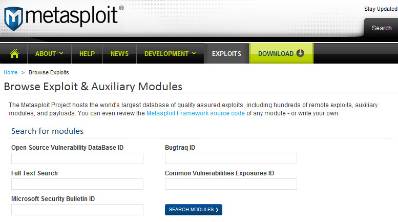Last updated at Thu, 18 Jan 2024 21:24:20 GMT

At Rapid7, we often get asked what the top 10 Metasploit modules are. This is a hard question to answer: What does "top" mean anyway? Is it a personal opinion, or what is being used in the industry? Because many Metasploit users work in highly sensitive environments, and because we respect our users' privacy, the product doesn't report any usage reports back to us.
We may have found a way to answer your questions: We looked at our metasploit.com web server stats, specifically the Metasploit Auxiliary and Exploit Database, which exploit and module pages were researched the most. Here they are, annotated with Tod Beardley's excellent comments:
- MS12-020 Microsoft Remote Desktop Use-After-Free DoS (CVE-2012-0002, MSB-MS12-020): This is the 2012 RDP Bug, where it was implied -- but never proven in public -- that a pre-auth bug in RDP can allow for remote code execution. This is likely the most popular module we have due to both recency bias and because there was an unusual level of spontaneous organization of the Metasploit developer community to search for the correct path to remote code execution. So far, nobody's gotten RCE yet (in public), but the Metasploit module provides the most clues.
- Microsoft Server Service Relative Path Stack Corruption (CVE-2008-4250, MSB-MS08-067): A four year old vulnerability that tends to give the most reliable shells on Windows 2003 Server and Windows XP. It's also got a great pile of language pack targets. All of Metasploit's exploits provide US English targeted shellcode, a few might provide Chinese, Spanish, French, or other popular languages; this one has targets in pretty much every language you've ever heard of. This exploit is also not ancient, so it's reasonable to expect to find some unpatched systems in a medium to large enterprise vulnerable to it.
- Microsoft Server Service NetpwPathCanonicalize Overflow (CVE-2006-3439, MSB-MS06-040): A six year old vulnerability that's notable in that there's no official patch from Microsoft for this on Windows NT 4.0. This was discovered after NT went end-of-life, so if you need remote root on an NT machine (and there are still plenty out there), this is going to be your first choice.
- Microsoft RPC DCOM Interface Overflow (CVE-2003-0352, MSB-MS03-026): A nine year old vulnerability that used to be the de-facto standard exploit for Windows machines -- this is the RPC DCom bug, and it affects ancient NT machines. It was most notable in that it was used by the Blaster and Nachi worms to transit networks. It's now pretty much a case study in stack buffer overflows in Windows, so it's got a lot of historical value. If memory serves, this was the most reliable exploit in Metasploit v2.
- Microsoft Windows 7 / Server 2008 R2 SMB Client Infinite Loop (CVE-2010-0017, MSB-MS10-006): Not sure why this module is popular -- it's a client side DoS. Historically, it's a neat DoS, since it demos a bug in Windows 7's kernel, but all the module does is crash Windows 7 clients after you get a user to connect to you.
- Adobe PDF Embedded EXE Social Engineering (CVE-2010-1240): This module exploits CVE-2010-1240 in Adobe Reader. The idea is that you can embed and execute a Meterpreter PE Executable in a PDF, and when the user opens the PDF, surprise shells! Since it's on this list, it's probably the most popular social engineering-style module.
- Apache mod_isapi <= 2.2.14 Dangling Pointer (CVE-2010-0425): Although this is an exploit in Apache, don't be fooled! It's only exploitable on Windows (so that knocks out the biggest chunk of Apache installs at the time of this module's release), and it's only a DoS. Again, kind of a mystery as to why it's so popular.
- Java AtomicReferenceArray Type Violation Vulnerability (CVE-2012-0507): This was initially discovered in the wild as a Java 0-day, and this module represented the fevered work of sinn3r and Juan Vazquez, who turned out the first reliable public cross-platform exploit for the bug. The blog post "CVE-2012-0507 - Java Strikes Again" shows a screenshot of Meterpreter sessions on Windows, Ubuntu, and OSX systems. In fact, this may be the first publicly demonstrable Java exploit that Just Works against all three platforms for the vulnerable versions of Java -- no extra configuration or fingerprinting is needed.
- Microsoft Windows Authenticated User Code Execution (CVE-1999-0504): The PSExec module is a utility module -- given an SMB username and password with sufficient privileges on the target machine, the user can get a shell. It's not sexy, but it's super handy for testing payloads and setup. Even though it's a lowly #9, I'd bet it's the most-used module in classroom and test environments.
- Microsoft Plug and Play Service Overflow (CVE-2005-1983, MSB-MS05-039): This exploits the Plug and Play service on Windows 2000. This is the exploit that MS06-040 replaced, though until MS06-040, this was the most reliable exploit around for Windows 2000. The Zotob worm used it. Note that while the exploit isn't 100% reliable, failed attempts had a tendency to trigger a reboot of the target, so the next attempt would be 100% successful. In other words, for some people, the reboot-on-failure is really more of a feature than a bug.
Let us know if you find this ranking interesting so we can continue sharing it in the future. We're excited to see how this list will look next month, and what the major changes will be!
If you want to use any of these exploits right now, you can download Metasploit for free!
